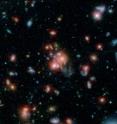Massive galaxy cluster found to be bursting with new stars
An international team of astronomers has discovered a distant massive galaxy cluster with a core bursting with new stars. The discovery, made with the help of W. M. Keck Observatory's MOSFIRE instrument, is the first to show that gigantic galaxies at the centers of massive clusters can grow significantly by feeding off gas stolen from other galaxies.
"It is very exciting to have discovered such an interesting object," said Gillian Wilson, a professor of physics and astronomy at the University of California, Riverside and a member of the research team. "Understanding its nature proved to be a real scientific challenge which required the combined efforts of an international team of astronomers and many of the world's best telescopes to solve."
Clusters of galaxies are rare regions of the universe consisting of hundreds of galaxies containing trillions of stars, plus hot gas and mysterious dark matter. The galaxies at the centers of clusters, called Brightest Cluster Galaxies (BCGs), are the most massive galaxies in the universe. How they become so huge is not well understood.
The study appears in The Astrophysical Journal.
The cluster known as "1049+56" was first identified from the UCR-led Spitzer Adaptation of the Red-sequence Cluster Survey, "SpARCS," which has discovered about 200 new distant galaxy clusters using deep ground-based optical observations combined with Spitzer Space Telescope infrared observations.
"What is so unusual about this cluster, SpARCS1049+56, is that it is forming stars at a prodigious rate, more than 800 solar masses per year," Wilson said. "To put that in perspective, our own galaxy, the Milky Way, is forming stars at the rate of only about one solar mass per year."
This surprising new discovery was the result of combining the power of ground-based observations from the W. M. Keck Observatory with observations from the Hubble, Spitzer and Herschel Space Telescopes. W. M. Keck Observatory observations with the powerful MOSFIRE infrared spectrograph were crucial to determining that SpARCS1049+56 is so far away that its light took 9.8 billion years to reach us, that it contains at least 27 galaxies and that it has a total mass equal to about 400 trillion Suns.
Because the Spitzer and Herschel Space Telescopes detect infrared light, they can see hidden, dusty regions of star formation. Those telescopes were able to reveal the full extent of the massive amount of star formation going on in SpARCS1049+56. However, the resolution of the infrared observations was insufficient to pinpoint where all this star formation was coming from.
"It took high-resolution follow-up optical observations from the Hubble Space Telescope to reveal 'beads on a string' at the center of SpARCS1049+56 which occur when, similar to a necklace, clumps of new star formation appear strung out like beads on filaments of hydrogen gas," Wilson said.
"Beads on a string" is a telltale sign of something known as a "wet merger," which occurs when at least one galaxy in a collision between galaxies is gas rich, and this gas is converted quickly into new stars. The large amount of star formation and the "beads on a string" feature in the core of SpARCS1049+56 are likely the result of the BCG in the process of gobbling up a gas-rich spiral galaxy.
"What is particularly interesting is that BCGs in clusters of galaxies closer to the Milky Way are thought to grow by so-called 'dry mergers,' collisions between gas-poor galaxies which do not result in the formation of new stars," Wilson said.
The new discovery is one of the only known cases of a wet merger at the core of a galaxy cluster, and the most distant example ever found.
The team now aims to explore how common this type of growth mechanism is in galaxy clusters. Are there other "messy eaters" out there similar to SpARCS1049+56, which are also munching on gas-rich galaxies? SpARCS1049+56 may be a rarity or it may be the first of many cases at early times in our universe when messy eating was the norm.
Source: University of California - Riverside
Articles on the same topic
- Astronomers find galaxy cluster with bursting heartThu, 10 Sep 2015, 18:38:37 UTC
- Astronomers discover how lowly dwarf galaxy becomes star-forming powerhouseWed, 9 Sep 2015, 18:03:16 UTC
Other sources
- Dwarf Galaxies Can Make Brilliant Star Clusters Too | Videofrom Space.comFri, 11 Sep 2015, 14:30:28 UTC
- A heart full of starsfrom European Space AgencyFri, 11 Sep 2015, 9:40:06 UTC
- Rare cosmic find: Astronomers find galaxy cluster with bursting heartfrom Science DailyThu, 10 Sep 2015, 18:30:31 UTC
- Astronomers find galaxy cluster with bursting heartfrom PhysorgThu, 10 Sep 2015, 18:00:21 UTC
- NASA Telescopes Find Galaxy Cluster with Vibrant Heartfrom NASA Jet Propulsion LaboratoryThu, 10 Sep 2015, 17:30:06 UTC
- 'Cosmic Tsunami' Shocks Comatose 'Sausage' Galaxy Cluster Into Star Formationfrom Space.comWed, 9 Sep 2015, 21:31:34 UTC
- Astronomers Discover How Lowly Dwarf Galaxy Becomes Star-Forming Powerhousefrom Newswise - ScinewsWed, 9 Sep 2015, 18:00:25 UTC
- Astronomers discover how lowly dwarf galaxy becomes star-forming powerhousefrom Science DailyWed, 9 Sep 2015, 18:00:18 UTC
- Astronomers discover how lowly dwarf galaxy becomes star-forming powerhousefrom PhysorgWed, 9 Sep 2015, 17:20:20 UTC
- Neutral hydrogen gas in galaxy clustersfrom PhysorgWed, 9 Sep 2015, 13:20:15 UTC

